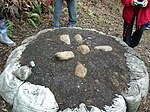| UNESCO World Heritage Site | |
|---|---|
 Dogū excavated at Kamegaoka (ICP), now at Tokyo National Museum Dogū excavated at Kamegaoka (ICP), now at Tokyo National Museum | |
| Location | Japan |
| Criteria | Cultural: (iii)(v) |
| Reference | 1632 |
| Inscription | 2021 (44th Session) |
| Area | 141.9 ha (0.548 sq mi) |
| Buffer zone | 984.8 ha (3.802 sq mi) |
Download coordinates as:
Jōmon Prehistoric Sites in Northern Japan (北海道・北東北の縄文遺跡群) is a serial UNESCO World Heritage Site consisting of 17 Jōmon-period archaeological sites in Hokkaidō and northern Tōhoku, Japan. The Jōmon period lasted more than 10,000 years, representing "sedentary pre-agricultural lifeways and a complex spiritual culture of prehistoric people".
It was first placed on the World Heritage Tentative List in 2009. In 2021, ICOMOS recommended the inscription in July of the revised serial nomination of seventeen sites under criteria iii and v. It was then officially inscribed on the World Heritage List on 27 July 2021.
Sites
All component sites have been designated for protection under the Law for the Protection of Cultural Properties, as Historic Sites or *Special Historic Sites ("ACA" column below).
See also
- List of National Treasures of Japan (archaeological materials)
- List of Historic Sites of Japan (Hokkaidō)
- List of Historic Sites of Japan (Aomori)
- List of Historic Sites of Japan (Iwate)
- List of Historic Sites of Japan (Akita)
- World Heritage Sites in Japan
References
- 土偶 [Dogū] (in Japanese). Agency for Cultural Affairs. Retrieved 28 July 2021.
- ^ "Jomon ruins added to UNESCO World Heritage List". The Japan Times. 27 July 2021. Retrieved 28 July 2021.
- "Jômon Archaeological Sites in Hokkaidô, Northern Tôhoku, and other regions". UNESCO. Retrieved 12 June 2012.
- ^ ICOMOS, ed. (2021). "Evaluations of Nominations of Cultural and Mixed Properties (WHC-21/44.COM/INF.8B1)" (PDF). UNESCO. pp. 339–349. Retrieved 24 July 2021.
- "Jōmon Prehistoric Sites in Northern Japan : Multiple locations". UNESCO World Heritage Centre. Retrieved 28 July 2021.
- "大平山元I遺跡 -日本最古の土器出土-" [Ōdaiyamamoto Ichi Site - Excavation of Japan's Earliest Earthenware] (in Japanese). Aomori Prefecture. Retrieved 12 June 2012.
- "青森県三内丸山遺跡出土品" [Excavated Artefacts from the Sannai-Maruyama Site] (in Japanese). Agency for Cultural Affairs. Retrieved 12 June 2012.
- "陸奥国是川遺跡出土品" [Excavated Artefacts from the Korekawa Site] (in Japanese). Agency for Cultural Affairs. Retrieved 12 June 2012.

















